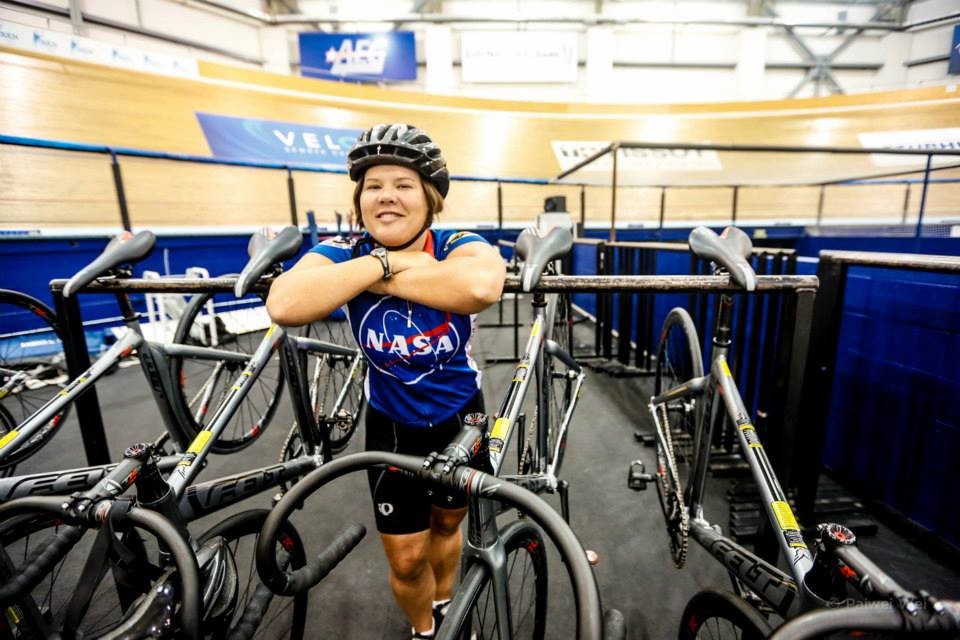Richmond grad builds plans that drive NASA’s rover and its scientific mission
Alumni
Amy Snyder Hale doesn’t just love science. She drives it.
As deputy rover planner team lead for NASA’s Curiosity mission at the Jet Propulsion Laboratory in California, Hale helps operate a one-ton robotic vehicle that’s been exploring the surface of Mars since 2012. She’s part of a small team of experts who plan and execute every command the rover receives — from its daily drives to collecting data.
“I tell people I play with Hot Wheels,” she said. “Except mine is the size of a Volkswagen Beetle, and it’s 140 million miles away.”
Hale didn’t arrive at the University of Richmond planning to one day help explore the solar system, but looking back, the signs were there.

If NASA ever asks for volunteers for a trip to Mars Amy Snyder Hale is game. “I would absolutely go. I already know the way." Hale enjoys traversing many terrains — from guiding the Curiosity rover on Mars to cycling to work each day.
At a very young age, she decorated her room in Connecticut with National Geographic maps and articles about space. She was always drawn to science and fascinated by space missions, but by the time she began applying to colleges, she didn’t have a clear career plan. Through the University Scholars Program, she received a full scholarship to Richmond. (Her parents, Elaine and Philip Snyder, are UR class of 1964 and 1963 graduates, respectively.) She eventually declared a physics major.
While Richmond didn’t offer astronomy or aerospace engineering, the University’s emphasis on undergraduate research gave Hale a formative early experience working with physics professor Gerard Gilfoyle. “It let me experience real science, the kind where there are no answers in the back of the textbook,” she said.
She learned how to collaborate, ask questions, and think.
A path to Mars with a few pivots
After graduating from UR in 1993, Hale pursued an advanced degree at the University of Pittsburgh. Starting in astronomy, she soon switched to planetary science, which combines geology with space exploration. “I wanted to work on missions. If I could’ve been an astronaut, I probably would have tried,” she said. Instead, she secured a postdoctoral position at NASA’s Jet Propulsion Laboratory and has been with them ever since.
Initially, she shot lasers at dirt to measure how light reflects off planetary surface materials, helping advance science that supports remote sensing of other environments beyond Earth. But she soon realized that proposal-writing and lab work weren’t her favorite part of the job. What excited her was being on the team that makes space missions run.
She found her niche in operations. “I got lucky,” said Hale, who technically works for the California Institute of Technology in a NASA-funded position. “Ever since, I’ve worked on missions that fly in space and do great things.
Now 25 years in, Hale is still excited by the work. “I get to drive a robot on another planet. That’s still unbelievably cool.”
Teamwork, terrain, and telling the rover where to go
As a rover planner, Hale helps drive the Curiosity rover by analyzing images sent from Mars, coordinating with scientists to determine goals, and building command sequences that tell the rover exactly what to do. Unlike what we see in the movies, she isn’t sitting in front of a video screen with a joystick moving the rover in real time. With a 10-minute one-way signal delay, every move must be meticulously planned and safely executed, usually a week in advance.
Built with a nearly $1 billion investment, Curiosity is the fourth rover to arrive on Mars. The Opportunity rover was lost after dust storms prevented its solar batteries from re-charging. Curiosity and Perseverance, its successor also now on Mars, use a radioactive heat source to generate electricity.
By now, Hale has mastered much of the planet’s topography, which is critical in developing drive plans that don’t overtax the rover’s capabilities. “We always have to remember that you can’t just pop the hood if something goes wrong.”
Beyond the rover, Hale serves as a science planner, which requires coordination with the mission’s science team. She balances research priorities, the rover’s power usage, and data constraints to ensure everything fits into a cohesive plan. Hale also helps operate the rover’s robotic arm, placing instruments on rocks or soils to study their chemical composition.
“We’re planning the activities that the rover does,” she said. “We look at the pictures, we talk to the scientists, they say, ‘We want to go over there,’ and then we figure out how to get there.”
Hale takes pride in enabling groundbreaking research. She’s not publishing papers, but she helps create the conditions for discovery. In fact, she was part of recent coverage in Science magazine, where the cover photo was track marks on Mars left by her rover.
“You learn about the universe in a deeper way when you can study it up close,” she said. “Mars used to have water. It underwent massive climate change. Studying it teaches us not just about other planets, but about our own.”
And as for what’s next? If NASA ever asks for volunteers for a trip to Mars – with the promise of a round-trip ticket – she’s game.
“I would absolutely go,” Hale said. “I already know the way.”

